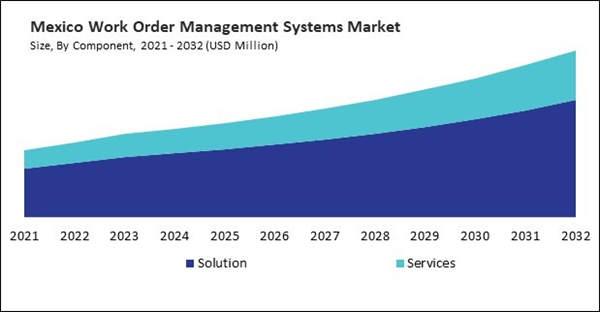The North America Work Order Management Systems Market is expected to witness market growth of 7.4% CAGR during the forecast period (2025-2032).
The US market dominated the North America Work Order Management Systems Market by country in 2024, and is expected to continue to be a dominant market till 2032; thereby, achieving a market value of $305.2 million by 2032. The Canada market is experiencing a CAGR of 9.2% during 2025-2032. Additionally, the Mexico market is expected to exhibit a CAGR of 8.4% during 2025-2032.
This market has emerged as a critical component in the operational framework of modern businesses, driven by the need for streamlined processes, enhanced efficiency, and improved resource utilization across various industries. As organizations increasingly prioritize operational excellence and customer satisfaction, work order management systems have become indispensable tools for managing maintenance, service, and operational tasks.
These systems provide a structured approach to creating, assigning, tracking, and completing work orders, enabling businesses to optimize workflows, reduce downtime, and enhance service delivery. With the rapid advancement of digital technologies, the market is experiencing significant growth, fuelled by the integration of innovative tools such as artificial intelligence (AI), the Internet of Things (IoT), and cloud-based platforms.
This market in North America is witnessing significant growth driven by the increasing demand for streamlined operational workflows and enhanced asset management across various industries such as manufacturing, utilities, healthcare, and facilities management. The USA holds a significant share in the global Work Order Management Systems market, driven by its highly advanced industrial sectors, technological innovation, and robust IT infrastructure. Canada’s WOMS market is characterized by steady growth fueled by ongoing infrastructure investments, a growing focus on smart utilities, and the expansion of the natural resources sector, including mining and oil sands. Mexico’s WOMS market is expanding rapidly due to industrial growth, especially in manufacturing, automotive, and energy sectors, driven by increased foreign investments and trade agreements such as USMCA. In conclusion, the markets in the USA, Canada, and Mexico each exhibit unique growth drivers shaped by their industrial landscapes, technological readiness, and regulatory frameworks.
The US market dominated the North America Work Order Management Systems Market by country in 2024, and is expected to continue to be a dominant market till 2032; thereby, achieving a market value of $305.2 million by 2032. The Canada market is experiencing a CAGR of 9.2% during 2025-2032. Additionally, the Mexico market is expected to exhibit a CAGR of 8.4% during 2025-2032.
This market has emerged as a critical component in the operational framework of modern businesses, driven by the need for streamlined processes, enhanced efficiency, and improved resource utilization across various industries. As organizations increasingly prioritize operational excellence and customer satisfaction, work order management systems have become indispensable tools for managing maintenance, service, and operational tasks.
These systems provide a structured approach to creating, assigning, tracking, and completing work orders, enabling businesses to optimize workflows, reduce downtime, and enhance service delivery. With the rapid advancement of digital technologies, the market is experiencing significant growth, fuelled by the integration of innovative tools such as artificial intelligence (AI), the Internet of Things (IoT), and cloud-based platforms.
This market in North America is witnessing significant growth driven by the increasing demand for streamlined operational workflows and enhanced asset management across various industries such as manufacturing, utilities, healthcare, and facilities management. The USA holds a significant share in the global Work Order Management Systems market, driven by its highly advanced industrial sectors, technological innovation, and robust IT infrastructure. Canada’s WOMS market is characterized by steady growth fueled by ongoing infrastructure investments, a growing focus on smart utilities, and the expansion of the natural resources sector, including mining and oil sands. Mexico’s WOMS market is expanding rapidly due to industrial growth, especially in manufacturing, automotive, and energy sectors, driven by increased foreign investments and trade agreements such as USMCA. In conclusion, the markets in the USA, Canada, and Mexico each exhibit unique growth drivers shaped by their industrial landscapes, technological readiness, and regulatory frameworks.
List of Key Companies Profiled
- Salesforce, Inc.
- IBM Corporation
- Microsoft Corporation
- Oracle Corporation
- SAP SE
- Infor, Inc. (Koch Industries)
- ServiceNow, Inc.
- UpKeep Technologies, Inc.
- Lula Smarter Property Maintenance, Inc.
- PTC, Inc.
Market Report Segmentation
By Organization Size
- Large Enterprise
- Small & Medium Enterprise (SME)
By Component
- Solution
- Services
By Deployment Mode
- Cloud
- On-premises
By End Use
- Manufacturing
- Transportation & Logistics
- Energy & Utilities
- Construction & Real Estate
- Consumer Goods & Retail
- Telecom and IT
- Healthcare & Life Sciences
- BFSI
- Other End Use
By Country
- US
- Canada
- Mexico
- Rest of North America
Table of Contents
Chapter 1. Market Scope & Methodology
Chapter 2. Market at a Glance
Chapter 3. Market Overview
Chapter 4. Competition Analysis - Global
Chapter 5. Value Chain Analysis of Work Order Management Systems Market
Chapter 6. Key Customer Criteria of Work Order Management Systems Market
Chapter 7. North America Work Order Management Systems Market by Organization Size
Chapter 8. North America Work Order Management Systems Market by Component
Chapter 9. North America Work Order Management Systems Market by Deployment Mode
Chapter 10. North America Work Order Management Systems Market by End Use
Chapter 11. North America Work Order Management Systems Market by Country
Chapter 12. Company Profiles
Companies Mentioned
- Salesforce, Inc.
- IBM Corporation
- Microsoft Corporation
- Oracle Corporation
- SAP SE
- Infor, Inc. (Koch Industries)
- ServiceNow, Inc.
- UpKeep Technologies, Inc.
- Lula Smarter Property Maintenance, Inc.
- PTC, Inc.









